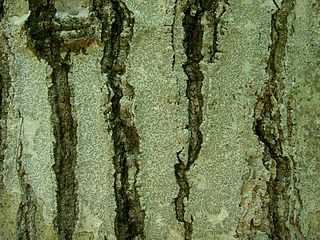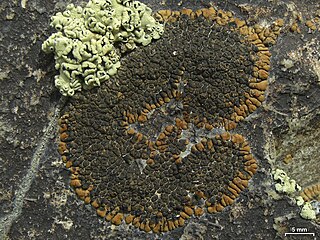
Eurotiomycetes is a large class of ascomycetes with cleistothecial ascocarps within the subphylum Pezizomycotina, currently containing around 3810 species according to the Catalogue of Life. It is the third largest lichenized class, with more than 1200 lichen species that are mostly bitunicate in the formation of asci. It contains most of the fungi previously known morphologically as "Plectomycetes".

The Amphisphaeriaceae are a family of fungi that is mainly found in parts of New Zealand, South America, Asia and parts of Europe. According to the 2007 Outline of Ascomycota, there were 41 genera placed within the family, although the position of 13 of those genera is uncertain. The 2020 Outline of Fungi and fungus-like taxa severely reduced the family to 4 members.
Biatorellaceae is a family of lichen-forming fungi in the subclass Lecanoromycetidae. The family is monotypic, and contains the single genus Biatorella, which contains eight species.

The Ostropomycetidae are a subclass of mostly lichen-forming fungi in the class Lecanoromycetes. The subclass was circumscribed in 2004 by Catherine Reeb, François M. Lutzoni, and Claude Roux. It contains ten orders and 36 families.

Texosporium is a genus of lichenized fungi in the family Caliciaceae. It is a monotypic genus, containing the single species Texosporium sancti-jacobi, found in the United States. The genus is characterized by microscopic features: the ascospores are coated with a layer of cells that are derived from the paraphyses. Texosporium was originally circumscribed by Josef Nádvorník in 1942, albeit the name was not validly published. In 1968, Leif Tibell and Angelica van Hofsten published the name validly. In 2020, Texosporium sancti-jacobi was added to the global IUCN Red List, where it is classified as endangered.

Sphaerellothecium is a genus of fungi in the family Phyllachoraceae. All of the species in the genus are lichenicolous, meaning they grow parasitically on lichens.
Antimanoa is a fungal genus in the division Ascomycota. The relationship of this taxon to other taxa within the division is unknown, and it has not yet been placed with certainty into any class, order, or family. This is a monotypic genus, containing the single species Antimanoa grisleae, originally collected from Venezuela. The genus and species were described as new to science in 1930 by German mycologist Hans Sydow.
Gallaicolichen is a fungal genus in the division Ascomycota. The relationship of this taxon to other taxa within the division is unknown, and it has not yet been placed with certainty into any class, order, or family. This is a monotypic genus, containing the single species Gallaicolichen pacificus, a foliicolous (leaf-dwelling) lichen.
Gyrophthorus is a genus of lichenicolous (lichen-dwelling) fungi in the phylum Ascomycota. The relationship of this taxon to other taxa within the phylum is unknown, and it has not yet been placed with certainty into any class, order, or family. The genus was circumscribed in 1990 by Josef Hafellner and Leopoldo Sancho, with Gyrophthorus perforans assigned as the type species.
Oevstedalia is a genus of fungi of uncertain placement in the subphylum Pezizomycotina. This is a monotypic genus, containing the single lichen species Oevstedalia antarctica. The genus was circumscribed by Damien Ertz and Paul Diederich in 2004. Previously classified in the Dothideomycetes, Oevstedalia was moved to Pezizomycotina incertae sedis due to the lack of DNA data available for the genus.
Phragmitensis is a genus of fungi in the Ascomycota phylum.
Cyanoannulus is a fungal genus in the family Annulatascaceae of the Ascomycota. This is in the monotypic order of Annulatascales of the class Sordariomycetes. It was formerly classed as Sordariomycetes class in 2007.
Fusoidispora is a fungal genus in the Annulatascaceae family of the Ascomycota. The relationship of this taxon to other taxa within the Sordariomycetes class is unknown, except that it is in subclass Diaporthomycetidae, and it has not yet been placed with certainty into any order. This is a monotypic genus, containing the single species Fusoidispora aquatica.

Arthrorhaphis is a genus of lichen-forming fungi in the monotypic family Arthrorhaphidaceae. It has 13 species. The genus was circumscribed by Theodor Magnus Fries in 1860. The family was proposed by lichenologists Josef Poelt and Josef Hafellner in 1976. Species in this family have a widespread distribution in temperate and montane habitats. They grow symbiotically with green algae, or parasitically on other lichens. The family Arthrorhaphidaceae has an uncertain taxonomic placement in the class Lecanoromycetes; that is, it is incertae sedis with respect to ordinal placement.
Harpidiaceae is a small family of lichen-forming fungi, containing two genera and five species. It is of uncertain classification in the Pezizomycotina.

Mastodia is a genus of lichen-forming fungi in the family Verrucariaceae. It has six species.
Constrictolumina is a genus of lichen-forming fungi in the family Trypetheliaceae. The genus was circumscribed in 2016 by Robert Lücking, Matthew Nelsen, and André Aptroot, with Constrictolumina cinchonae assigned as the type species. The genus contains tropical species, formerly placed in genus Arthopyrenia, with a unique hamathecium.
Cameronia is a genus of crustose lichens in the monotypic family Cameroniaceae. It has two species. Both the genus and its two species were described as new to science in 2011 by Australian lichenologist Gintaras Kantvilas. Characteristics of the genus include its chlorococcalean photobiont partner, and perithecioid ascomata that are deeply immersed in the substrate. Microscopic features of Cameronia include the four-spored asci with an intensely hemiamyloid outer wall and non-amyloid, well-developed tholus, and hyaline, muriform ascospores. Both species are endemic to the Tasmanian Highlands.
Xenus lithophylli is a species of lichenized ascomycete fungus discovered in 1992, composing the entire monotypic genus Xenus. It is found parasiting the calcified algae Lithophyllum, and lives attached to corals in Belize, in the Caribbean.
Helocarpaceae is a family of lichen-forming fungi in the subclass Lecanoromycetidae. The family is monotypic, and contains the single genus Helocarpon.






